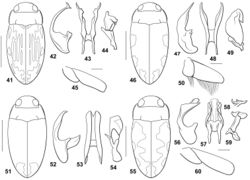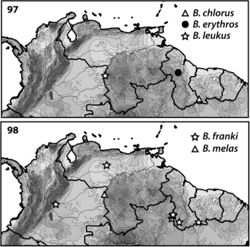Bidessodes franki
| Notice: | This page is derived from the original publication listed below, whose author(s) should always be credited. Further contributors may edit and improve the content of this page and, consequently, need to be credited as well (see page history). Any assessment of factual correctness requires a careful review of the original article as well as of subsequent contributions.
If you are uncertain whether your planned contribution is correct or not, we suggest that you use the associated discussion page instead of editing the page directly. This page should be cited as follows (rationale):
Citation formats to copy and paste
BibTeX: @article{Miller2017ZooKeys, RIS/ Endnote: TY - JOUR Wikipedia/ Citizendium: <ref name="Miller2017ZooKeys">{{Citation See also the citation download page at the journal. |
Ordo: ORDO
Familia: FAMILIA
Genus: Bidessodes
Name
Bidessodes franki (Spangler, 1981) – Wikispecies link – Pensoft Profile
- Youngulus franki Spangler, 1981:71.
- Bidessodes (Youngulus) franki, Young, 1986: 209; Biström, 1988: 7; Nilsson, 2016: 98.
Diagnosis
Males and females do not have a medially modified prosternum. The prosternal process is flat, the lateral margins are convergent to the broadly pointed apex. The male mesotibia is unmodified. Bidessodes franki are unique in having males with an extremely broad metatrochanter and metafemur with a distinctive fringe of setae along their posterior margins (Fig. 50). The male abdominal ventrite VI is apically distinctly impressed, and broadly impressed laterally. The male genitalia are distinctive with the median lobe in ventral aspect deeply bifid with each branch unforked and tapered to a point (Fig. 47). In lateral aspect the median lobe is medially very broad and apically strongly tapered and straight to a sharp apex (Fig. 48). The lateral lobe has a reduced basal segment and the apical segment large and irregularly margined with a distinctive lobe on the apicodorsal margin that is directed basally (Fig. 49). Specimens are robust, relatively large and have maculate elytra (Fig. 46).
Distribution
Found across northern South America from central Colombia to southern Suriname (Fig. 98).
Taxon Treatment
- Miller, K; 2017: A review of the Neotropical genus Bidessodes Régimbart, 1895 including description of four new species (Coleoptera, Adephaga, Dytiscidae, Hydroporinae, Bidessini) ZooKeys, (658): 9-38. doi
Images
|

